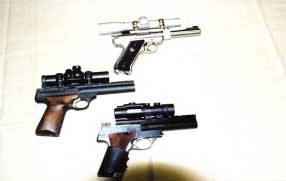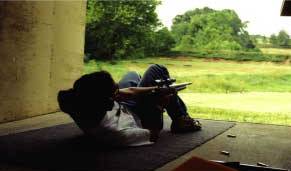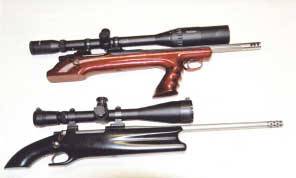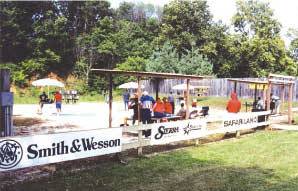|
There will always be a special place in my heart for this match. Its
home for the last 18 years has been at beautiful PASA Park in Barry, Illinois.
It is held the first week in August, and has drawn the top shooters from every
conceivable shooting style known to man. They soon find out though, that being
the best at just one particular form of handgun shooting just doesn’t quite cut
it. It requires lots of practice, dependable equipment, and hands-on knowledge
of multiple shooting disciplines. Roll this all together with a top-notch
Range Officer staff, a relaxed and friendly park atmosphere, and down home
cooking that would make Grandma envious, and you have the Masters International
Shooting Championship.
In order to accommodate all shooting skill
levels, competition classes are divided into Professional, Sportsman
(amateur), and Stock. There is also a Ladies category and a Junior
division (under 18) for our shooters of tomorrow. Novice shooters
are welcomed annually by additional prize incentives
and the Masters Bring-A-Buddy program. If an existing Masters
competitor can persuade a friend or fellow shooter to enter, he can
shoot the match for one half the standard entry fee in his Category
for the first year only. This new shooter is eligible for all
awards, trophies, and prizes just as if he had paid full price. In
an effort to bring in more new shooters, or only to satisfy some of
the competitors’ desire to just "shoot more," the Stock Class was
added to the Masters venue. The Stock Class is for Sportsmen
shooters only with prizes the same as the regular Unlimited Class
Masters competition. A Stock Class gun means an ordinary
store-bought, factory production; regular over-the-counter gun with
tuned-up original equipment parts only, no add-ons or accessories.
Optical sights can be used for only two Events in Stock Class. This
way a competitor that likes to play hard can run once with his high
end, open class custom guns, then shoot again with his stock guns.
The Masters is a
combination of three basic types of handgun shooting; Bullseye, Speed Shooting,
and Metallic Silhouette. These three "Events" weigh equally into your total
score. The first one we will cover is the Precision Event. This event uses the
Camp Perry or the Olympic style Bullseye format. It is a test of the shooter’s
basic marksmanship abilities and is fired one handed, unsupported, in the
classic Bullseye stance. It requires the competitor to shoot 45 shots at 45
total targets, using five shot strings, at 25 to 50 meters distances. Each
string is under different time constraints ranging from 10 seconds to 120
seconds. One phase is shot in "duel sequence". With your start position at
International ready, a timer beep gives you 3 seconds to raise your gun and pull
the trigger on a 25 meter target. You then go back to your rest and wait seven
seconds for the next beep. This is repeated for 5 total shots to complete the
string. The Precision Event uses Biathlon style steel reactive targets. When the
target falls, a colored cover plate comes up to cover the hole. This way the
shooter immediately knows if his hit was good and the spectators can keep track
of their favorite shooter as it happens.
Popular guns for this event include Pardini, Hammerli, Smith & Wesson
model 41, and Bennelli for the open class and Ruger, High Standard, or Browning
for stock. The most important part is to find one that fits you and the way that
you shoot. Since optics can be used here, the popular electronic red dot sight
or the standard crosshair scope of various magnifications is seen on almost
every gun on the line. These help squeeze as much pinpoint accuracy as possible
out of your firearm.
|
 |
|
Guns of the Masters |
The next stage, known as the Long Range Event, is modeled after the
IHMSA handgun metallic silhouette competition. Like the precision event, there
are 45 shots allowed to hit 45 targets. Only these metal plates are much larger,
heavier, and a whole lot farther away. The plates come in 6", 9", and 12"
diameter and are set at distances ranging from 75 to 200 meters. This is a very
visually impressive match to watch. The neat rows of brightly painted
fluorescent pink and green targets of different sizes set against the natural
green valley of PASA before the covered twelve bay firing line is quite a sight.
Then, when the start beep sounds, the air comes alive with the blast of a dozen
guns firing and the clanging of metal plates as they are knocked from their
stands. Long range shooting is usually very relaxed and centered mainly on
accuracy, but the shorter time restrictions of each string at the Masters put
everything in a whole different light. The first of three phases of Long Range
requires you to shoot from a standing position at 10 targets 75 and 100 meters
away, engaged at alternating distances, in 90 seconds. Then you shoot at five
targets, set at alternating heights, in 60 seconds. The second phase can be shot
from the freestyle shooting position of your choice. There, the same target
engagement structure is used, but at distances of 100 to 200 meters. The 60
second string is at 200 meters and the staggered plates are a mere 6" size.
|
 |
|
This should
look familiar to silhouette shooters |
Hitting all five of these is an accomplishment in itself. The last phase, also
similar in structure, alternates from 150 to 200 meters. After all that, the
last 60 second string of 9" plates at 150 meters must be engaged, once again,
from a standing position. Sounds intense? It is!
The guns most commonly used are bolt action, single shot handguns in
6mm caliber or higher. Good examples of these are the Savage Striker, Remington
XP-100, or Ultra Lite Arms. Sometimes grips are modified to front, mid, or rear
grip configuration, depending on the shooter’s preference. Thompson Center
Contenders with their multiple calibers are also excellent choices as well as
some big bore revolvers in 44 Magnum or maybe Smith & Wesson’s new 500 S&W
Magnum revolver. Handgun scopes using between 4 to 10 power or sometimes a rifle
scope with even more magnification are used, depending on the particular gun’s
setup. This event has sparked more imaginative gunsmithing amongst competitors
than perhaps any other match in history. This is possibly one of the reasons for
the popularity of the Stock Class in the last few years. It helps bring the
focal point of the competition back from an equipment race to a truer test of a
shooter’s skill.
|
 |
|
Guns
of the Masters |
The fitting finish to peak the excitement at the Masters is the
spectators’ favorite part of the match, the Action Event. This is the fast
paced, quick draw, split second competition that will bring out the best
or the worst in a shooter. There is no perfect score as in Precision or
Long Range. It is simply the fastest time wins. For those who have never
seen this event, the shooter must draw his gun at the start beep from a
surrender position and knock over five steel plates with a maximum six
shots. There are three separate reactive target arrays steel plates of
various sizes and shapes. The target array designs are usually changed
every 3-4 years just to give it a new look and not get into "the same
thing every year" rut like the Bianchi Cup. You are allowed three passes
at each array. If you have a blow out or just don’t shoot a string like
you know you can, there is one "do over" throw out pass available to the
competitor. The only stipulation is you get that new time whether you did
better or worse. The shooter’s time from his nine attempts are added
together and his percentage of the fastest time is his score. There are
also procedural penalties to consider. Two seconds will be added to your
score for any plate left standing or any extra shot over the six allowed
per string. So the desire to draw and hose must be tempered with control
so as not to go over the edge.
Most guns used in Practical Shooting or the Steel Challenge would be
good to go in the Action Event. Calibers from 9mm to .45 ACP with a power factor
of 125 or more are acceptable. The gun list here could be extensive but John
Browning’s 1911 semi-automatic design and all of its clones are the most
prevalent. There are also many Smith & Wesson revolvers along with Taurus, Glock,
Sig, and many other Service type guns that are appearing once again because of
Stock Class.
On the last day after the dust has cleared and the new Master has been
crowned, its time to unwind and have some shoot-off fun. First is the Local Hero
Shoot-off for the Sportsmen that shoot, but also serve as our beloved Range
Officers and support staff of the Masters. This is followed by the High 16
Shoot-off where the best of the best square off Man on Man for final bragging’
rights.
Past Masters winners include Alan Fulford-2, Frank Glenn-2, Brian Enos,
Ken Tapp, Merle Edington, and Wayne Bowker. But you couldn’t talk about the
Masters without mentioning its most prolific champion, Doug Koenig. Doug has
come away with 10 top place wins in 18 years of the match. Among his many
individual records Doug has done the one thing that the Masters creators never
thought would be possible, score 100% in all three events. So if you have the
idea of being the next Masters champion, Doug Koenig is the man to beat.
Throughout the course of the Masters there are also outstanding Rifle,
Rimfire Rifle, and Shotgun side matches that can be attended during the
competitors free time, all of which have separate entry and prize schedules.
There it is! The Masters is a fun but challenging shooting competition
open to all types and levels of ability. Guns can range from high-end custom
machines, to the good ol’ plinkers and tin can shooters that you have lying
around in your cabinet. With a little initiative and some good old-fashioned
practice, anything is possible. Which brings us to the inevitable question; Are
you ready to shoot the Masters?
|



